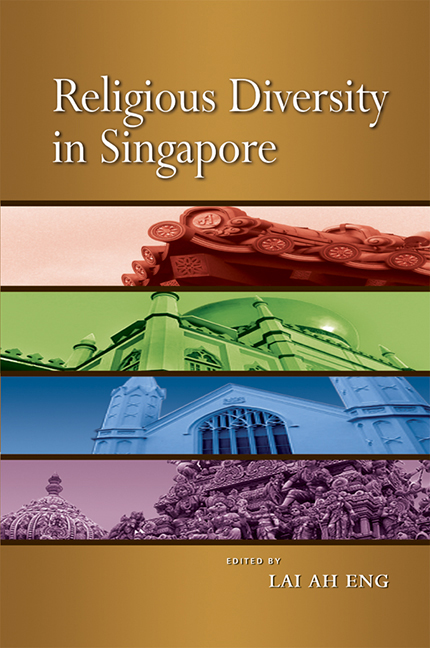Book contents
- Frontmatter
- Contents
- List of Figures and Tables
- List of Appendices
- FOREWORD
- PREFACE
- Acknowledgements
- The Contributors
- Abbreviations
- Glossary
- INTRODUCTION
- PART I The Landscape of Religious Diversity
- 1 Religious Influences and Impulses Impacting Singapore
- 2 Religious Trends and Issues in Singapore
- 3 Keeping God in Place: The Management of Religion in Singapore
- 4 Discourses on Islam in Southeast Asia and Their Impact on the Singapore Muslim Public
- 5 Global Christian Culture and the Antioch of Asia
- 6 “Religiously-inspired”, “India-derived” Movements in Singapore
- 7 Baha'is in Singapore: Patterns of Conversion
- 8 Diversities and Unities: Towards a Reformist Buddhism in Singapore
- 9 The Sathya Sai Baba Movement in Singapore: Its Service Mission and Philosophy of Communal Identity Construction
- 10 The Muslim Religious Elite of Singapore
- 11 The Evolution of the Sikh Identity in Singapore
- 12 Religious Processions: Urban Politics and Poetics
- PART II Religion in Schools and Among the Young
- PART III Religion in the Media
- PART IV Religious Organizations in Social Services
- PART V Interfaith Issues and Interaction
- Index
6 - “Religiously-inspired”, “India-derived” Movements in Singapore
from PART I - The Landscape of Religious Diversity
Published online by Cambridge University Press: 21 October 2015
- Frontmatter
- Contents
- List of Figures and Tables
- List of Appendices
- FOREWORD
- PREFACE
- Acknowledgements
- The Contributors
- Abbreviations
- Glossary
- INTRODUCTION
- PART I The Landscape of Religious Diversity
- 1 Religious Influences and Impulses Impacting Singapore
- 2 Religious Trends and Issues in Singapore
- 3 Keeping God in Place: The Management of Religion in Singapore
- 4 Discourses on Islam in Southeast Asia and Their Impact on the Singapore Muslim Public
- 5 Global Christian Culture and the Antioch of Asia
- 6 “Religiously-inspired”, “India-derived” Movements in Singapore
- 7 Baha'is in Singapore: Patterns of Conversion
- 8 Diversities and Unities: Towards a Reformist Buddhism in Singapore
- 9 The Sathya Sai Baba Movement in Singapore: Its Service Mission and Philosophy of Communal Identity Construction
- 10 The Muslim Religious Elite of Singapore
- 11 The Evolution of the Sikh Identity in Singapore
- 12 Religious Processions: Urban Politics and Poetics
- PART II Religion in Schools and Among the Young
- PART III Religion in the Media
- PART IV Religious Organizations in Social Services
- PART V Interfaith Issues and Interaction
- Index
Summary
NAMING A ‘NEW’ PHENOMENON: A QUESTION OF TERMINOLOGY
In the course of research for this chapter, I discovered an interesting collection of theoretical works on the subject of “new religious movements” (NRMs), four of which were especially eye-catching: The Historical Dictionary of New Religious Movements (2001), edited by George D. Chryssides; The Oxford Handbook of New Religious Movements (2004), edited by James R. Lewis; Encyclopedia of New Religious Movements (2005), edited by Peter B. Clarke and Encyclopedia of New Religions, New Religious Movements, Sects and Alternative Spiritualities (2004), edited by Christopher Partridge. It is significant that in the year 2006, a student of the field of “new religions” has access to an accumulated body of resources such as historical dictionaries, encyclopedias, handbooks and guidebooks in addition to an astonishing array of empirical data about NRMs across the globe and sophisticated theorizing about a subject that, only a short fifty years ago, was still in its infancy. This suggests three important points: (1) the phenomenal global growth of “new religious movements”, especially in the second half of the twentieth century, (2) the huge scholarly interest in the phenomenon as well as creative attempts to make sense of it, and (3) the institutionalization of this sub-field of study in the social sciences. Expectedly, the emergent field is not defined by consensus; instead, the vibrant debates within have raised fundamental questions about definitions, concepts and modes of theorizing this new phenomenon. It is beyond the scope of this chapter to enter these discussions in detail; only one strand of the conversation is relevant to the present purpose: the question of definitions.
Scholars agree that something “new” is happening in religious domains globally, and that novel and innovative expressions of religiosity are not only asserted by participants but also that different kinds of evidence for this are pervasive. A primary challenge is to figure out how this “new” religious style is to be discoursed and theorized, and this entails addressing the following questions: How are these individuals (with a new religious style) who have organized themselves into collectivities and their religious ideas to be denoted? Do they constitute a new religion?
- Type
- Chapter
- Information
- Religious Diversity in Singapore , pp. 142 - 166Publisher: ISEAS–Yusof Ishak InstitutePrint publication year: 2008

